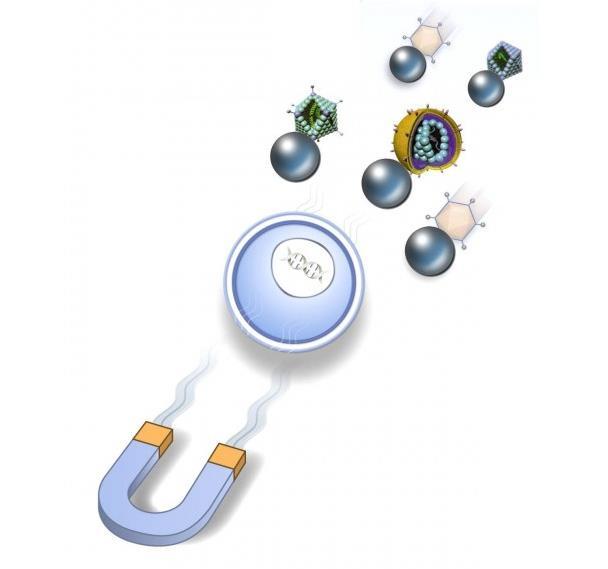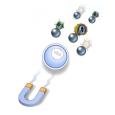方案详情
文
ViroMag是唯一可为这类应用提供解决方案的试剂。病毒染色体和要转导的病毒一步混合;不需要分子生物学过程或生化修饰。该试剂在促进、控制和协助病毒转导方面具有异常高的效率。
方案详情

OZ生物科学公司很高兴地宣布推出了一种基于磁对流TM技术的新产品,专门为病毒应用而设计: ViroMag。磁切™是一种新的革命性的核酸传递系统。它利用磁力将与磁性粒子相关的核酸载体和病毒驱动向并进入目标细胞。通过这种方式,完全应用剂量的病毒迅速集中在细胞表面,使100%的细胞同时接触到所有剂量的病毒。ViroMag Results Virus Types 心 OZ Biosciences is delighted to announce the launching of a new product based on the Magnetofection TMtechnology, specifically designed for viral application: ViroMag. MagnetofectionTM is a new revolutionary nucleicacids delivery system. It exploits magnetic force to drive the nucleic acids vectors and virus associated withmagnetic particles towards and into the target cells. In this way, the complete applied dose of virus getsconcentrated onto the cells surface very rapidly so that 100% of the cells get in contact simultaneously with allviral doses. ViroMag is a versatile and unique solution for many viral applications. ViroMag allows scientist to: √ Increase transduction efficiency and accelerate transduction process Infect non permissive cells √Concentrate virus onto cells or in culture medium √ Synchronize cell adsorption (infection) without modification of the viruses ViroMag is the only reagent available offering a solution to such applications. ViroMag and virus to betransduced are mixed in a one-step procedure; no molecular biology process or biochemical modifications arerequired. This reagent demonstrates an exceptionally high efficiency to promote, control and assist viraltransductions. ViroMag is applicable to all viral vectors and present unique properties allowing to: 1. Increase transduction efficiency in terms of percentage of transduced cells2. Concentrate the entire viral dose on the cells very rapidly and accelerate the transduction process.3. Infect non permissive cells4. Significantly improve virus infectivity with extremely low vector doses. 5. Synchronize cell adsorption / infection 6. Target/confine transduction to specific area (magnetic targeting) Based upon a validated and recognized magnetic drug targeting technology this innovative method is: Highly Efficient ● Suitable for all viruses ● Economical, Simple & Rapid ● Universal (primary cells, hard-to-transfect cells and cell lines) Q Serum compatible & Non toxic ● Amenable to high throughput automation OZ Biosciences offers 4 types of ready-to-use reagents: √ ViroMag engineered to be combined with all viruses PolyMag suitable for all nucleic acids and all transfection application CombiMag designed to be associated with all transfection reagents SilenceMag created specifically for all siRNA applications. ViroMag reagent can generally be combined with any viruses. If a particular virus is not listed, this does notimply that ViroMag is not going to work. OZ Biosciences is maintaining an updated list of virus successfullytested that is available on the website: www.ozbiosciences.com. Virus Type Virus name Adenovirus/ Adeno-Associated Virus Lentivirus / Retrovirus Ad5 LacZ, Ad5-PEG HIV, MuLV, MLV HSV-I Herpes virus Alpha virus Sindbis virus Baculovirus Rhabdovirus VSV Polyomavirus SV40 Paramyxovirus Measles Cell Types ViroMag is applicable and has been tested successfully on a variety of immortalized cell lines (293-HEK CHO,B95a, HeLa, HT1080, K562, L, NIH3T3, VERO, BT4C...) and primary cells (PAEC, PBL...). Please consult ourupdated list of cells successfully tested available on the website: www.ozbiosciences.com. ViroMag is generallyapplicable on numerous cell types, but if a particular cell type is not listed, this does not imply that ViroMag isnot going to work. OZ Biosciences is going to frequently update this list. Application examples of magnetic nanoparticles including ViroMag for viral applications ViroMag increases transduction efficiency 1) Adenovirus a) The combination of paramagnetic nanoparticles with adenovirus has shown up to 500-fold enhancement ofgene expression compared with standard infection 1, 2. Transduction of suspension cells (K562 and humanperipheral blood lymphocytes) has been seen only with magnetic nanoparticules 1-3. Enhancement of Adenovirus(Ad5 vector) transduction has also been reported on CHO cells “. In addition, magnetic field-guided localtransduction was demonstrated in vivo (stomach) with an adenovirus combines to magnetic nanoparticles 3x 10 NIH 3T3 cells (6 well-plate), 3 x 10 K562cells (24 well-plate) and 3 x 10 PBL (96 well-plate)were infected with of recombinant adenovirus (codingfor LacZ) +/- ViroMag. . NIH3T3 were transduced with 200 MOI +/- 3pL ViroMag. K562 were transduced with 200 MOI +/-6pL ViroMag. PBL were transduced with 500 MOI +/- 3pL ViroMag b) In the same way, Pandori et al. have reported that nanoparticles conjugate to Adenovirus significantlyenhance their ability to transduce target cells in vitro 5. This approach required a chemical modification of viralenvelopes or viral surface proteins to contain the binding moiety to the magnetic nanoparticles. This lengthy approach and the genetic modification of viral envelopes strategy have shown limited success in many occasionsand a more straightforward method is preferable. In contrast, ViroMag allows you to achieve identical results,in one step procedure to associate virus and paramagnetic nanoparticles, without the requirement of geneticallyor biochemically modifying your virus. 2) Adeno-associated virus (AAV). The transduction efficiency of cells infected with AAV bound to magneticmicropsheres has been shown to be 10-fold higher than unbound vectors in HeLa cells 6. In this report, higherand localized transduction efficiency was also achieved in vivo when AAV bounds to magnetic particles wereadministered either intramuscularly or intravenously. 3) Retrovirus/Lentivirus a) Pseudo-typed HIV-I viruses carrying a luciferase reporter gene were produced in 293 cells. Supernatantscontaining the recombinant HIV-1-Luc viruses (rHIV-Luc) were associated with ViroMag or not at a ratio of 1 pLof ViroMag per mL of rHIV-Luc supernatant. Mixtures were added to U87-CD4-CCR5 cells and luciferase activitywas measured at 72 hours. ViroMag clearly increased the HIV-1 infection efficiency as shown in figure below. 0.5 x 105 U87-CD4-CCR5 cells (96 ell-plates)) were infected with a recombinantHIV-1-Luc +/- ViroMag and+/--tthemagnetic field.LLuciferaseactivity Wasmeasured 72h post-transduction. b) The infectivity of lentiviruses (HIV-1 and a pseudotype lenti-VSVG) has been shown to be increased by about100-fold when the virus were adsorbed on magnetic nanoparticles'. c) A magnetic retroviral vectors formed by the combination of paramagnetic nanoparticles and a Retrovirus(Moloney Leukemia Virus) demonstrated major higher gene transduction efficiency. 4) Measles Virus. Kadota, S.I., et al. 2005. J. Virol. Methods-0 Magnetofection enhanced the infection of adenoviruses and retroviruses. It is also shown that Magnetofectionenhances the infection of measles virus, a paramyxovirus 10. When cells expressing a measles virus receptorhuman SLAM were infected with a measles virus that encodes the green fluorescent protein, Magnetofectionenhanced measles virus infection by 30- to 70-fold. The infection of SLAM-negative cells with measles virus wasalso enhanced by Magnetofection, but to a lesser extent. These results indicate that Magnetofection could beuseful for isolation of measles virus from clinical specimens. 5) Baculovirus in vitro transduction efficiency has been significantly increased with magnetic particles ViroMag concentrates viral dose, promotes and accelerates the infection process √ concentrate viral dose and accelerate the infection process 1-12 1) Retrovirus/Lentivirus. a) Concentration of viruses from cell culture supernatants has been reported wherein retroviral titers could beincreased by 1000 to 4000 fold. b) The rate of retroviral infection is primarily limited by diffusion-dependent cell association. Association of aLentivirus (HIV-I) with magnetic nanoparticles has led to a considerable concentration of the viral dose on cellsurface ’. Cellular uptake of HIV-1 was increased by 70-fold. c) Concentration and acceleration of the infection process has also been demonstrated with a pseudo-typedHIV-I virus carrying a luciferase reporter gene. Pseudo-typed HIV-I viruses carrying a luciferase reporter genewere produced in 293 cells. Supernatants containing the recombinant HIV-1-Luc viruses (rHIV-Luc) wereassociated or not with ViroMag at a ratio of 1 pL of ViroMag per mL of rHIV-Luc supernatant. Mixtures wereadded to U87-CD4-CCR5 cells with or without magnetic field. In order to monitor the time course of infection,virus supernatant was washed out after 0.5, 1, 2, 4 and 6 hours and luciferase activity measured at 72 h. 2) Adeno-associated virus (AAV). 1% of AAV vector bound to magnetic particles resulted in same level oftransduction than 100% of the free vector due mainly to their concentration on cell surfaces. √ Isolate virus from low virus containing samples with ViroMag_10, 12 1) Concentration of measles virus 10. Magnetofection allow the detection of transduction when measles virusstock solution (5x10"TCIDso) was diluted up to 125-fold 2) Non enveloped virus (SV40) and enveloped virus such as Sindbis virus, HSV type I and VSV have alsobeen successfully concentrated with magnetic nanoparticules (up to 100 times for DNA viruses and up to 1000fold for RNA viruses) to enhance the sensitivity of virus detection by polymerase chain reaction 12. Satoh et al.have reported a reduced infectivity of the viruses associated with magnetic nanoparticles having a size of 0.8pmin diameter and coupled to a very large polymer. This is not surprising since the beads size preclude tointernalization and infection and the polymer biological activity is extremely low. In contrast, ViroMag smallnanoparticles formulation is concentrating viruses in the same way and is improving viruses’ infectivity asdemonstrated for various types of viruses due to their small size and the particularly active polymers associated1-4,10,11 √Magnetic nanoparticles can restore transduction efficiency Transduction efficiency of PEGylated adenovirus has been restored by the use of paramagnetic nanoparticles“.Polyethylene Glycol (PEG) conjugate to adenoviral capsid can protect the vectors from neutralizing antibodies,vector pharmacokinetics and reduce innate immune response. However, when the adenoviral vector PEGylationprovides safe features it also blocks in vitro transduction. Association of PEGylated adenovirus with magneticparticles can restore and even increase transduction efficiency in comparison to unmodified adenovirus. ViroMag improves viral infectious capacity Retrovirus/Lentivirus a) Enhancement of infectivity with ViroMag. Low retroviral titer preparation was associated to ViroMag and usedto transduce NIH-3T3 cells 1-3. Whereas no transductions were observed with virus alone, ViroMag led in a 20-fold enhancement over a standard transduction approach consisting of Virus plus polybrene (see figure below). b) Improvement of retrovirus infectivity was also demonstrated by Hughes et al. 20 times infectivityenhancement was achieved with a high retroviral titer when combined to paramagnetic particles c) The infectivity of a lentivirus was shown to be clearly increased when associated with paramagneticnanoparticles in comparison to the virus alone’. This enhancement of infectivity was seen even at low MOI. ViroMag extends the host tropisms to non permissive cells 1) Adenoviruses a) Adenoviral infections are dependent on the presence of CAR receptor on the cells surface. Unfortunately,many important and interesting target tissues for fundamental research and gene therapy are non-permissive toviral gene delivery (tumor tissues and apical surface of lung epithelium may express variable, little or none ofthe required receptors). The association of viral vectors with ViroMag is sufficient to force infection of non-permissive cells (lacking CAR) as shown with adenovirus in NIH 3T3, K562 cells and human peripheral bloodlymphocytes 1,2. Without Magnetic field With Magnetic field 3 x 10 NIH 3T3 cells (lacking CAR) were infected with a constantdose (200 MOI) of recombinant adenovirus (coding for LacZ) +/-ViroMag in the presence (right) and in the absence (left) ofpermanent magnets positioned under the culture plates in a 6 well-plate. 1) Virus alone 2) PBS plus ViroMag (6pl) 3) & 4) Virus plus ViroMag (3pl) 5) & 6) Virus plus ViroMag (6pl) We are grateful to Dr. C. Plank and Dr. M. Anton (Technical University, Munich) for kindly providing these data. b) Likewise, Pandori et al. have shown that nanoparticles conjugate to Adenovirus allow transduction of lesspermissive cell line (C6) with a 20-fold transduction improvement over the free virus 5. Most importantly asdescribed above, they also demonstrated the possibility to infect cells markedly non-permissive (COLO 205) toadenovirus only after association with nanoparticles. ViroMag allows you to achieve identical results without therequirement of biochemical modification of your virus. 2) Measles virus. Infection of SLAM-negative cells (VERO, HeLa, CHO and L cells) with the measles virus has beendescribed with very low dose of virus (5x10"TCIDs0)10. ViroMag allows the synchronization of the transduction Synchronized infection by HIV-1 of primary endothelial cells was reported with the use of magnetic nanoparticles’. The number of productive adsorption events by virus alone reached a maximal level after 20h whichcorresponds to a decrease in residual infectivity left in the culture medium. In contrast, when virus wascomplexed onto paramagnetic nanoparticles optimum cellular uptake was reached after 1 minute. Thismagnetically controlled viral adsorption is advantageous to synchronize infection and to accurately monitor thekinetics of viral replication cycle. ViroMag can provide a magnetic targeting 1) A recombinant adenovirus carrying the LacZ gene (200 MOI)was combined with ViroMag and incubated on NIH 3T3 cells (lackingCAR) in the presence (left) and in the absence (right) of a magneticfield for 5 minutes. High transduction can be achieved undermagnetic influence and can be confined to the area where themagnet has been positioned. Similar results have been publishedwith the same technology1. 2) In another study, a specific targeting to define area has been shown with a recombinant adenoviruscarrying the LacZ gene coupled to microbeads or to paramagnetic microparticles 5. This paper has used a stylishdesign to clearly demonstrate the magnetically targeted transduction. 3) Targeting the region of transduction has also been reported with an adeno-associated virus complexed tomagnetic microsphere6. 4) In the same way, magnetic targeting confine to specific area has been reported with an avidin modifiedBaculovirus 11. ViroMag allows you to achieve identical results without the requirement of genetically orbiochemically changing your virus. 5) In vitro magnetic targeting has also been demonstrated with Retrovirus 9. In this manuscript the elegantdesign of the magnet shape strongly show a confine and specific targeting to the area dictated solely by thepresence of the magnet. In another report, site specific delivery was obtained with a magnetic retroviral vector(MLV)8. Please consult our list of references available on the website: www.ozbiosciences.com. Adenovirus: 1. Scherer F, et al. Magnetofection: enhancing and targeting gene delivery by magnetic force in vitro and invivo. Gene Ther. 2002; 9(2):102-9. 2.Plank C, et al. Enhancing and targeting nucleic acid delivery by magnetic force. Expert Opin Biol Ther. 2003;3(5):745-58. 3.SSchillinger, U., et al. Advances in Magnetofection - magnetically guided nucleic acid delivery. 2005.J.Magn.Magn. Mat. 293:501-508. 4.Mok, H., et al. Evaluation of polyethylene glycol modification of first-generation and helper-dependentadenoviral vectors to reduce innate immune responses. 2005. Mol. Ther. 11(1): 66-79. 5.Pandori, M.W., et al. Adenovirus-Microbead Conjugates Possess Enhanced Infectivity: A New Strategy toLocalized Gene Delivery. 2002. Virology 299: 204-212. Adeno-Associated Virus: 6.Mah, C., et al. Improved Method of Recombinant AAV2 Delivery for Systemic Targeted Gene Therapy. 2002.Mol. Ther. 6(1): 106-112. Retrovirus / Lentivirus: 7. Haim, H., et al. Synchronized infection of cell cultures by magnetically controlled virus. 2005. J. Virol. 79(1):622-5. 1. Scherer F, et al. Magnetofection: enhancing and targeting gene delivery by magnetic force in vitro and invivo. Gene Ther. 2002; 9(2):102-9. 8.Tail et al. Generation of magnetic retroviral vectors with magnetic nanoparticles. 2003. Rev. Adv. Mater. Sci.5:319-323 9. Hughes, C., et al. Streptavidin paramagnetic particles provide a choice of three affinity- based capture andmagnetic concentration strategies for retroviral vectors. 2001. Mol. Ther. 3(4): 623-30. Measles Virus: 10. Kadota, S.I., et al. Enhancing of measles virus infection by magnetofection. 2005. J. Virol. Methods. Baculovirus: 11.Raty, J.K., et al. Enhanced gene delivery by avidin-displaying baculovirus. 2004. Mol. Ther. 9(2):282-91. Alpha virus, Herpes virus, Polyomavirus (SV40) 12. Satoh et al. Virus concentration using polyethyleneimine-conjugated magnetic beads for improving thesensitivity of nucleic acid amplification tests. J. Virol. Methods 114: 11-19
确定
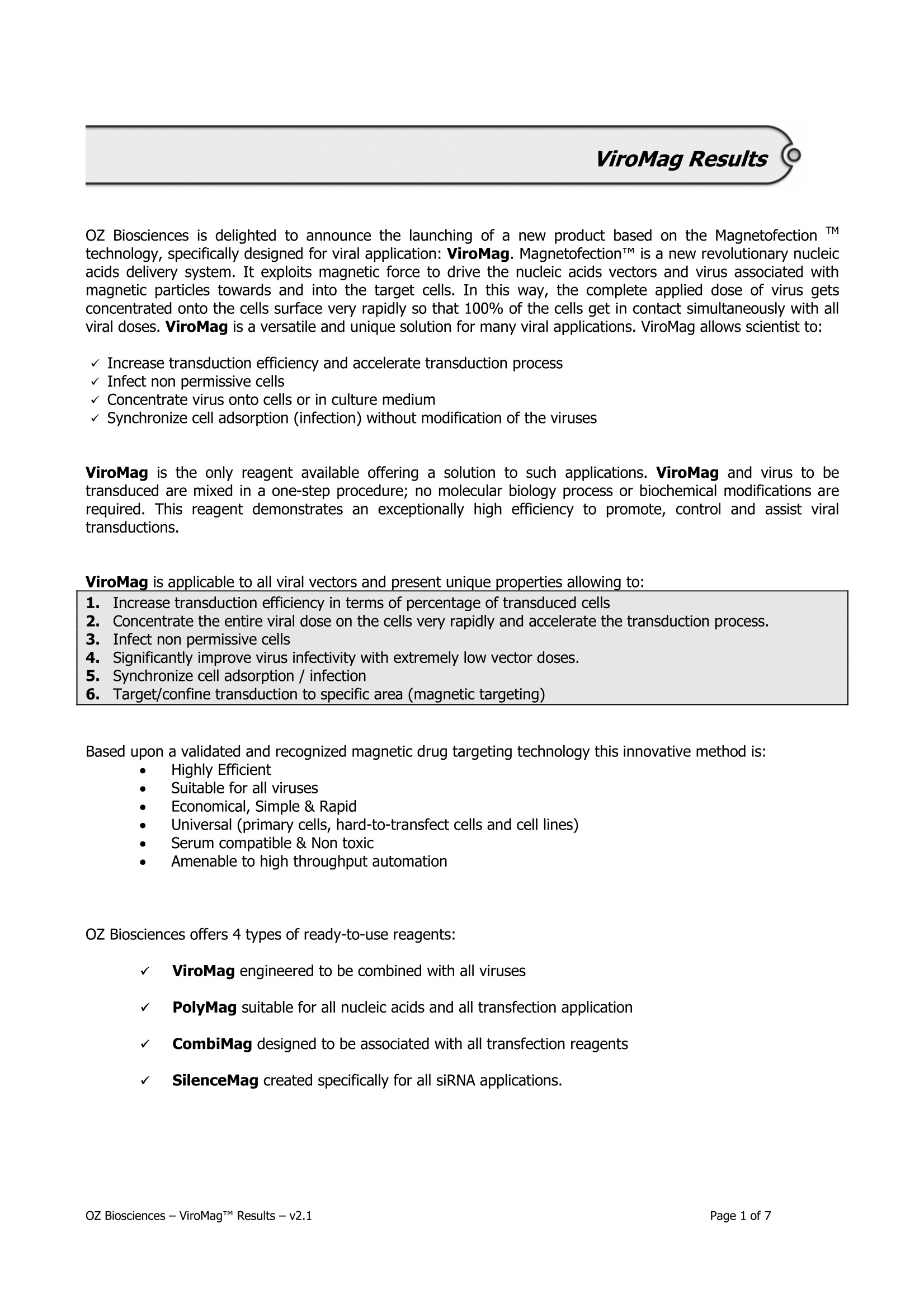
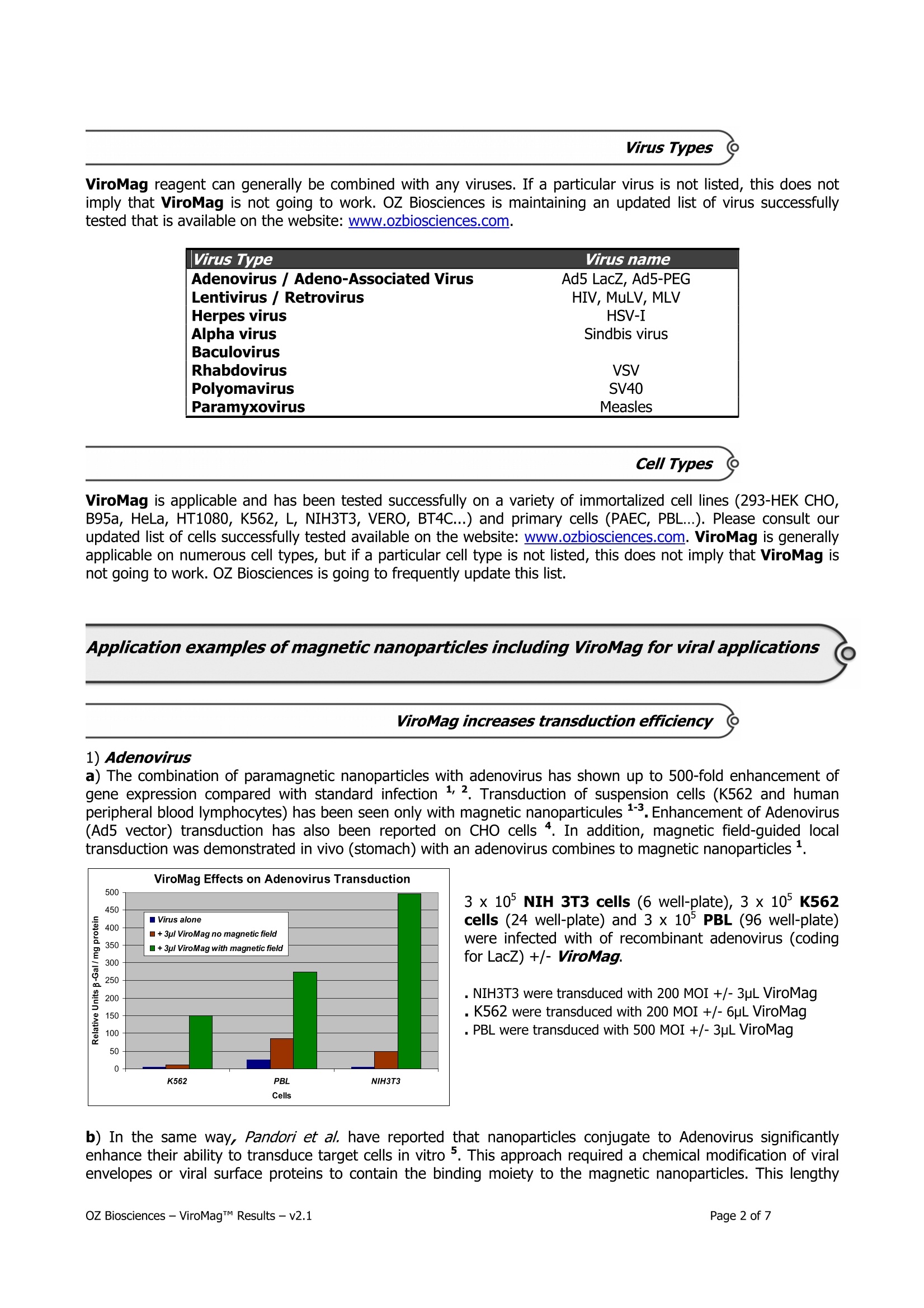
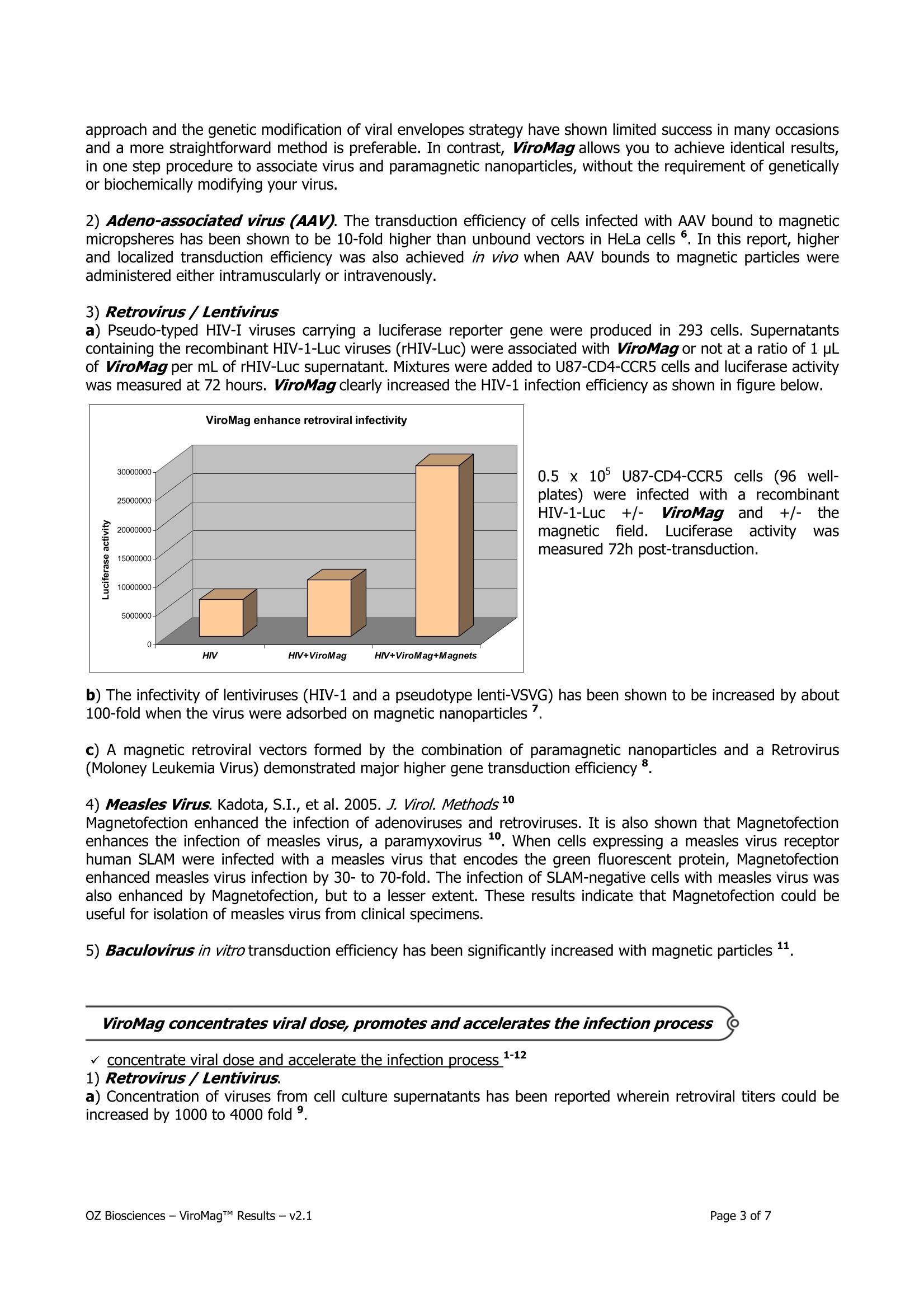
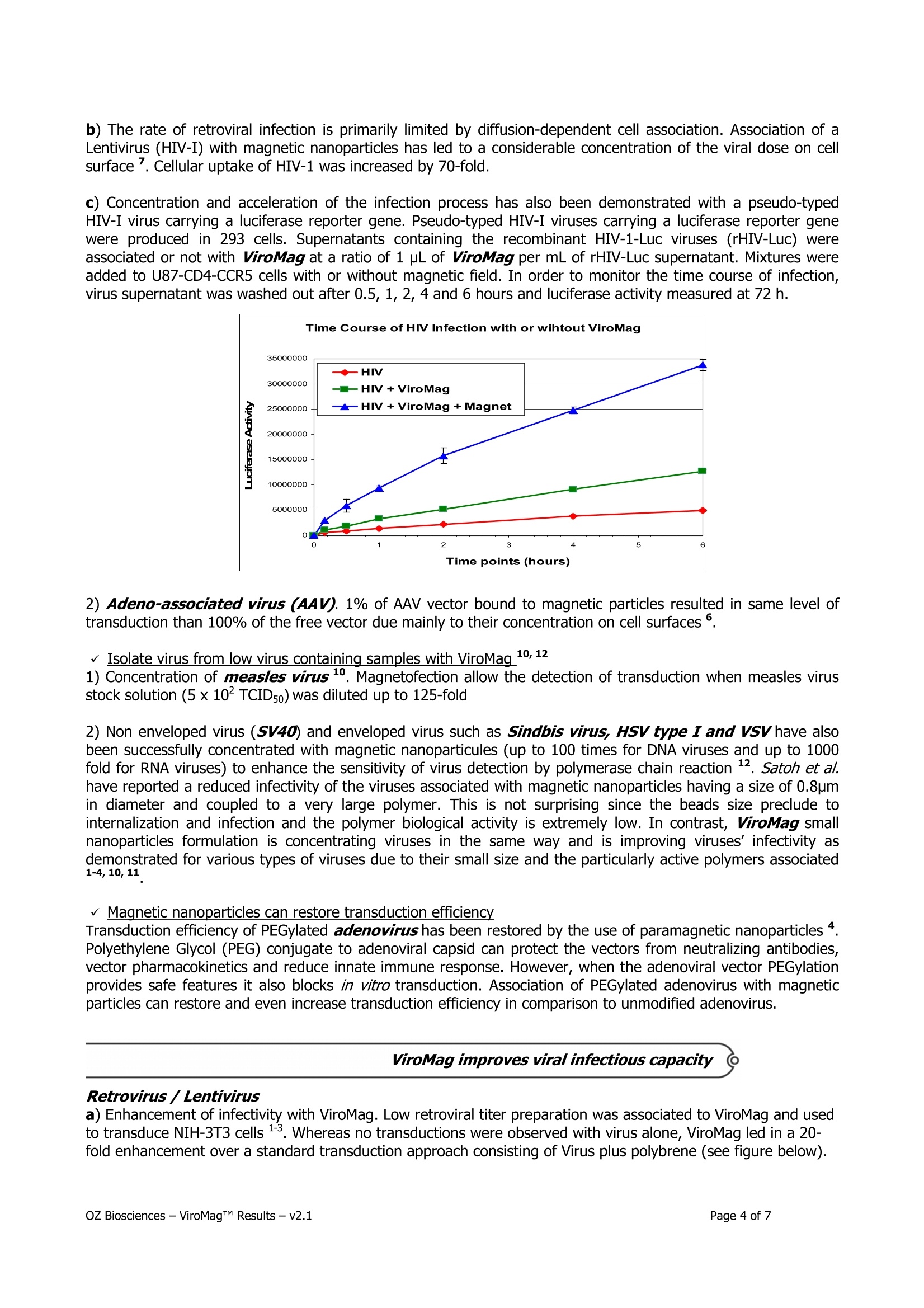
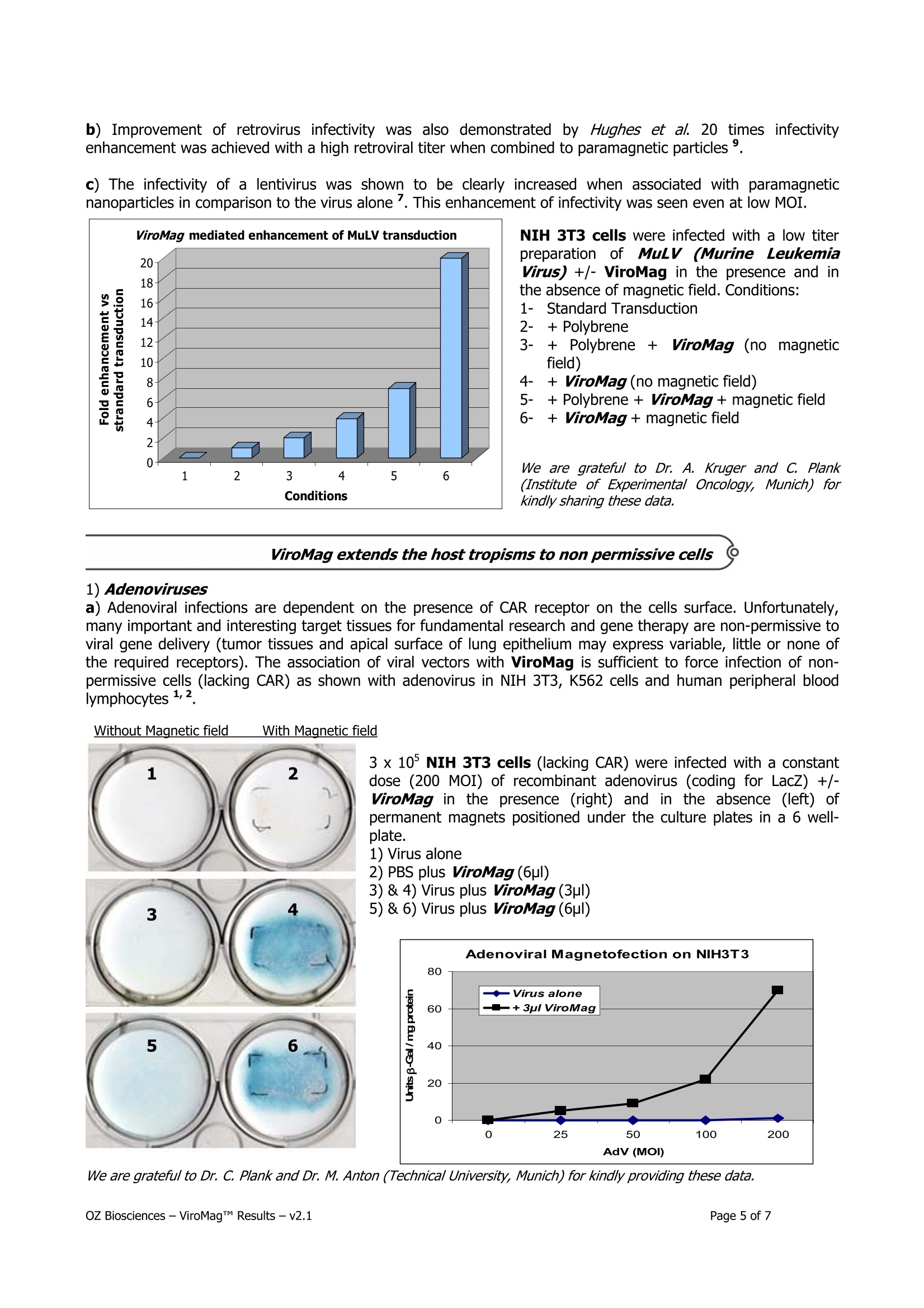
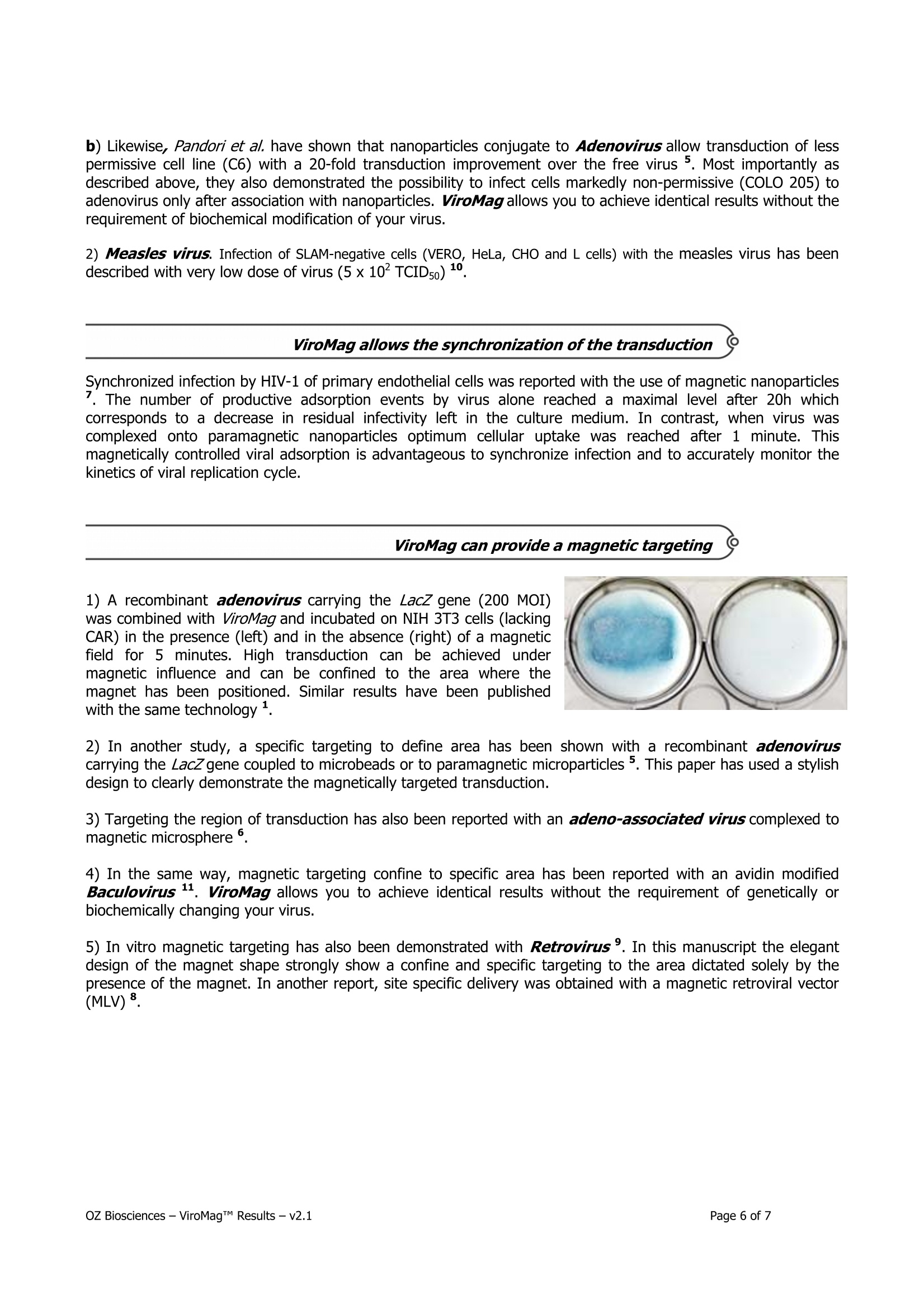
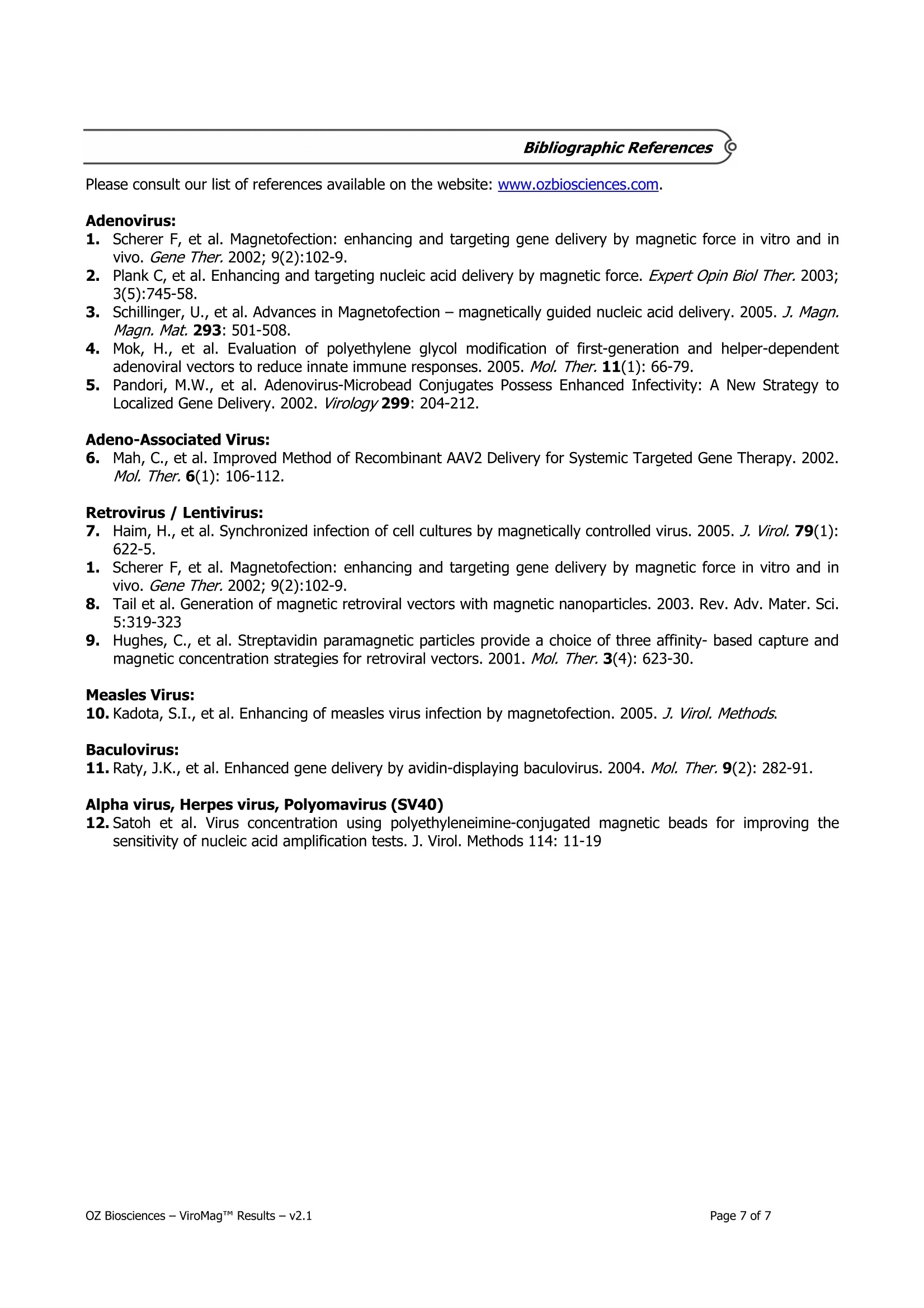
还剩5页未读,是否继续阅读?
上海迹亚国际商贸有限公司为您提供《OZ.MagnetofectionTM核酸递送开创性产品》,该方案主要用于其他中核酸递送检测,参考标准--,《OZ.MagnetofectionTM核酸递送开创性产品》用到的仪器有OZ biosciences Viromag转导增强剂
相关方案
更多
该厂商其他方案
更多

